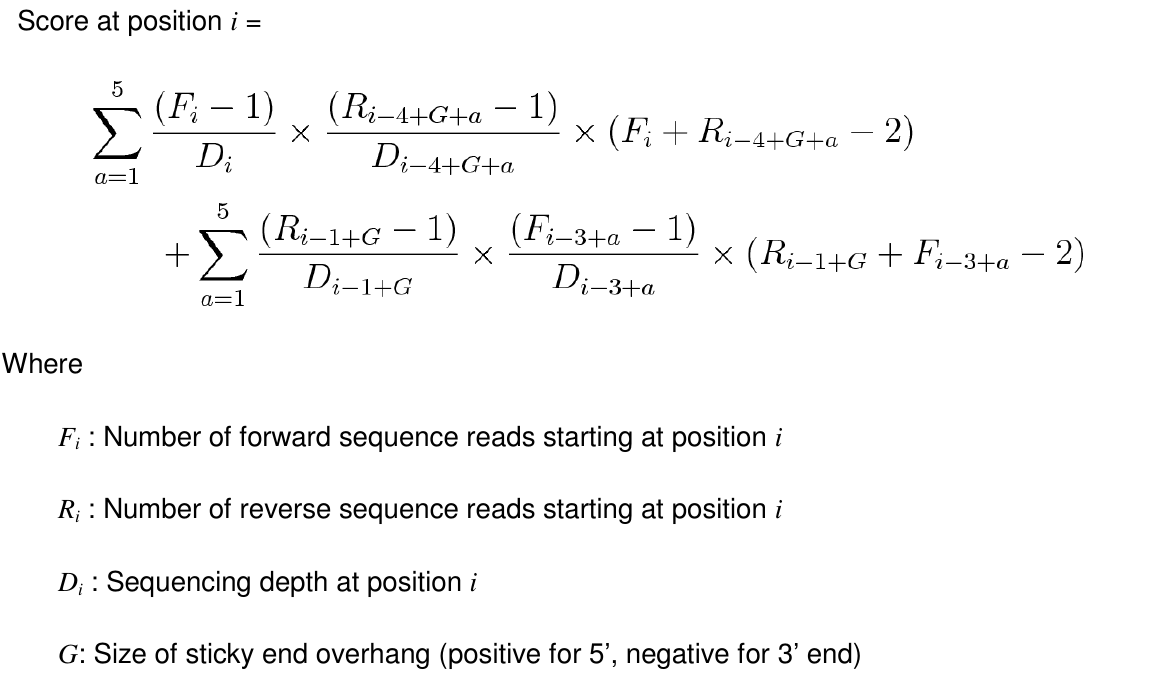Digenome-sequencing
Help
Example data
- WT BAM file (1002 KiB*): click to download
- Cas9 treated BAM file (517 KiB*): click to download
- Reference genome: Human (GRCh37)
- Target sequence (SpCas9): 5'-CTTGCCCCACAGGGCAGTAACGG-3'
* The above BAM files are NOT a full Digenome-seq data, they only contain reads near the DSB sites detected from the original full sized BAM files. You can also try Digenome-seq analysis with original BAM files stored at ENA (study accession number: PRJEB20021).
DNA cleavage score
We assigned a DNA cleavage score to each nucleotide position across the human genome using the following equation to identify in vitro DNA cleavage sites. Value of 2.5 is recommended.

Example protocol of Digenome-seq
Digenome-seq pinpoints the exact location of double strand break (DSB) sites with blunt or cohesive ends caused by various programmable nucleases such as CRISPR, ZFNs, TALENs by recognizing specific patterns of aligned reads. After finding candidate DSB sites with Digenome-seq, the real off-target sites need to be verified using targeted deep sequencing. We provide a brief example protocol below.
1. Prepare nucleases for in vitro DNA cleavages.
We prepare DNA nucleases such as CRISPR and ZFNs. For CRISPR-Cas9 nucleases, recombinant Cas9 protein was purified from Escherichia coli as described previously (Cho, S. W. et al. Nat. Biotechnol. 31, 230–232 (2013).) or purchased from ToolGen (South Korea). sgRNAs were synthesized by in vitro transcription using T7 RNA polymerase.
2. In vitro cleavage of genomic DNA.
First, sufficient amounts of genomic DNA were purified from the cells of interest. Then, we digested target sequences in the genome with the prepared DNA nucleases. For CRISPR-Cas9 nucleases, we mixed Cas9 protein (0.004–40 μg), which had been preincubated with sgRNA (0.003–30 μg) at room temperature for 10 min, with genomic DNA (8 μg) in a reaction volume of 400 μl (100 mM NaCl, 50 mM Tris-HCl, 10 mM MgCl2, and 100 μg/ml BSA) and incubated at 37 °C for 8 h. Then we purified the digested genomic DNAs with DNeasy Tissue kit (Qiagen) after RNase A (50 μg/ml) was added to remove sgRNA.
3. Perform whole-genome sequencing and make data as a BAM format.
With the digested genomic DNAs, we performed whole-genome sequencing (WGS) and mapped the sequencing data to the reference genome producing alignment in BAM format. The BAM files were then sorted by co-ordinate. We carried out WGS using an Illumina HiSeq X Ten Sequencer and aligned the resulting reads with Isaac aligner (ver. 01.14.03.12). Briefly, genomic DNA (1 μg) was fragmented using the Covaris system (Life Technologies) and polished to generate blunt ends using End Repair Mix. Fragmented DNA was ligated with adaptors to produce libraries, which were then subjected to WGS using an Illumina HiSeq X Ten Sequencer at Macrogen. Then, we mapped using the Isaac aligner (Raczy, C. et al. Bioinformatics 29, 2041–2043 (2013)) with parameters: Human genome reference, hg19 from UCSC (original GRCh37 from NCBI, Feb. 2009); Base quality cutoff, 15; Keep duplicate reads, yes; Variable read length support, yes; Realign gaps, no; and Adaptor clipping, yes (adaptor: AGATCGGAAGAGC*,*GCTCTTCCGATCT). We recommend to do WGS for both mock-treated and nuclease-treated cells to compare the off-target sites together.
4. Use a web-based Digenome-seq program.
The BAM files resulting from the alignment were analyzed with Digenome-seq using default parameters to obtain the exact location of the DNA cleavage sites.
5. Validation of off-target sites in cells using targeted deep sequencing.
Off-target sites were validated by inducing double-strand break (DSB) of DNA in a cell and inspecting the DNA mutations at the potential off-target sites, which were obtained from Digenome-seq, using targeted deep sequencing (Cho, S. W. et al. Genome Res. 24, 132-141 (2014)). Candidate sites were amplified using Phusion polymerase (New England Biolabs) then PCR amplicons were denatured by NaOH and subjected to paired-end sequencing using Illumina MiSeq. Indel frequencies were calculated using Cas-Analyzer.
For more information, please e-mail to us.